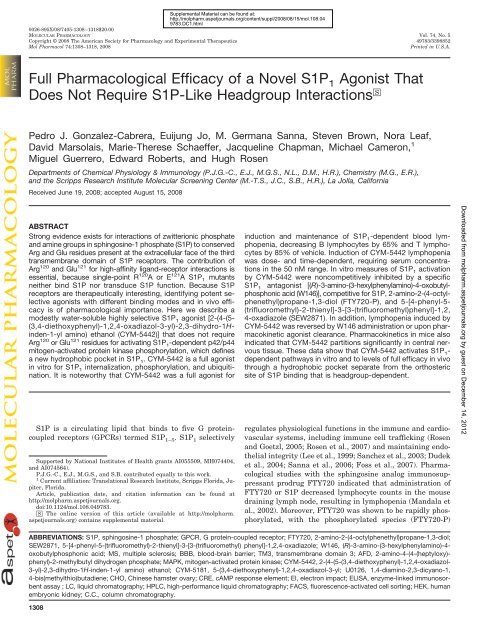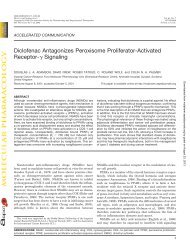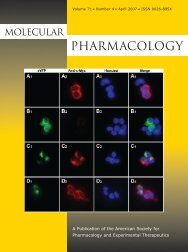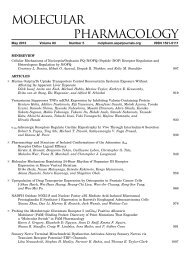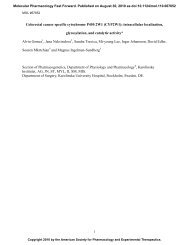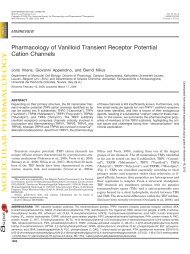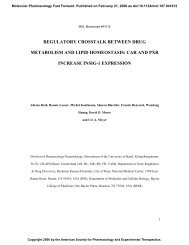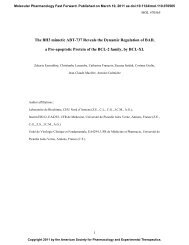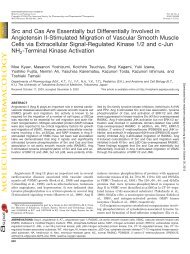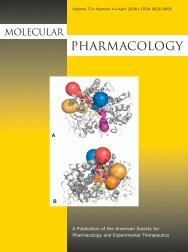Full Pharmacological Efficacy of a Novel S1P1 Agonist That Does ...
Full Pharmacological Efficacy of a Novel S1P1 Agonist That Does ...
Full Pharmacological Efficacy of a Novel S1P1 Agonist That Does ...
You also want an ePaper? Increase the reach of your titles
YUMPU automatically turns print PDFs into web optimized ePapers that Google loves.
Supplemental Material can be found at:<br />
http://molpharm.aspetjournals.org/content/suppl/2008/08/15/mol.108.04<br />
9783.DC1.html<br />
0026-895X/08/7405-1308–1318$20.00<br />
MOLECULAR PHARMACOLOGY Vol. 74, No. 5<br />
Copyright © 2008 The American Society for Pharmacology and Experimental Therapeutics 49783/3398852<br />
Mol Pharmacol 74:1308–1318, 2008 Printed in U.S.A.<br />
<strong>Full</strong> <strong>Pharmacological</strong> <strong>Efficacy</strong> <strong>of</strong> a <strong>Novel</strong> S1P 1 <strong>Agonist</strong> <strong>That</strong><br />
<strong>Does</strong> Not Require S1P-Like Headgroup Interactions □S<br />
Pedro J. Gonzalez-Cabrera, Euijung Jo, M. Germana Sanna, Steven Brown, Nora Leaf,<br />
David Marsolais, Marie-Therese Schaeffer, Jacqueline Chapman, Michael Cameron, 1<br />
Miguel Guerrero, Edward Roberts, and Hugh Rosen<br />
Departments <strong>of</strong> Chemical Physiology & Immunology (P.J.G.-C., E.J., M.G.S., N.L., D.M., H.R.), Chemistry (M.G., E.R.),<br />
and the Scripps Research Institute Molecular Screening Center (M.-T.S., J.C., S.B., H.R.), La Jolla, California<br />
Received June 19, 2008; accepted August 15, 2008<br />
ABSTRACT<br />
Strong evidence exists for interactions <strong>of</strong> zwitterionic phosphate<br />
and amine groups in sphingosine-1 phosphate (S1P) to conserved<br />
Arg and Glu residues present at the extracellular face <strong>of</strong> the third<br />
transmembrane domain <strong>of</strong> S1P receptors. The contribution <strong>of</strong><br />
Arg 120 and Glu 121 for high-affinity ligand-receptor interactions is<br />
essential, because single-point R 120 A or E 121 A S1P 1 mutants<br />
neither bind S1P nor transduce S1P function. Because S1P<br />
receptors are therapeutically interesting, identifying potent selective<br />
agonists with different binding modes and in vivo efficacy<br />
is <strong>of</strong> pharmacological importance. Here we describe a<br />
modestly water-soluble highly selective S1P 1 agonist [2-(4-(5-<br />
(3,4-diethoxyphenyl)-1,2,4-oxadiazol-3-yl)-2,3-dihydro-1Hinden-1-yl<br />
amino) ethanol (CYM-5442)] that does not require<br />
Arg 120 or Glu 121 residues for activating S1P 1-dependent p42/p44<br />
mitogen-activated protein kinase phosphorylation, which defines<br />
a new hydrophobic pocket in S1P 1. CYM-5442 is a full agonist<br />
in vitro for S1P 1 internalization, phosphorylation, and ubiquitination.<br />
It is noteworthy that CYM-5442 was a full agonist for<br />
S1P is a circulating lipid that binds to five G proteincoupled<br />
receptors (GPCRs) termed S1P 1–5. S1P 1 selectively<br />
Supported by National Institutes <strong>of</strong> Health grants AI055509, MH074404,<br />
and AI074564).<br />
P.J.G.-C., E.J., M.G.S., and S.B. contributed equally to this work.<br />
1 Current affiliation: Translational Research Institute, Scripps Florida, Jupiter,<br />
Florida.<br />
Article, publication date, and citation information can be found at<br />
http://molpharm.aspetjournals.org.<br />
doi:10.1124/mol.108.049783.<br />
□S The online version <strong>of</strong> this article (available at http://molpharm.<br />
aspetjournals.org) contains supplemental material.<br />
induction and maintenance <strong>of</strong> S1P 1-dependent blood lymphopenia,<br />
decreasing B lymphocytes by 65% and T lymphocytes<br />
by 85% <strong>of</strong> vehicle. Induction <strong>of</strong> CYM-5442 lymphopenia<br />
was dose- and time-dependent, requiring serum concentrations<br />
in the 50 nM range. In vitro measures <strong>of</strong> S1P 1 activation<br />
by CYM-5442 were noncompetitively inhibited by a specific<br />
S1P 1 antagonist [(R)-3-amino-(3-hexylphenylamino)-4-oxobutylphosphonic<br />
acid (W146)], competitive for S1P, 2-amino-2-(4-octylphenethyl)propane-1,3-diol<br />
(FTY720-P), and 5-[4-phenyl-5-<br />
(trifluoromethyl)-2-thienyl]-3-[3-(trifluoromethyl)phenyl]-1,2,<br />
4-oxadiazole (SEW2871). In addition, lymphopenia induced by<br />
CYM-5442 was reversed by W146 administration or upon pharmacokinetic<br />
agonist clearance. Pharmacokinetics in mice also<br />
indicated that CYM-5442 partitions significantly in central nervous<br />
tissue. These data show that CYM-5442 activates S1P 1dependent<br />
pathways in vitro and to levels <strong>of</strong> full efficacy in vivo<br />
through a hydrophobic pocket separate from the orthosteric<br />
site <strong>of</strong> S1P binding that is headgroup-dependent.<br />
regulates physiological functions in the immune and cardiovascular<br />
systems, including immune cell trafficking (Rosen<br />
and Goetzl, 2005; Rosen et al., 2007) and maintaining endothelial<br />
integrity (Lee et al., 1999; Sanchez et al., 2003; Dudek<br />
et al., 2004; Sanna et al., 2006; Foss et al., 2007). <strong>Pharmacological</strong><br />
studies with the sphingosine analog immunosuppressant<br />
prodrug FTY720 indicated that administration <strong>of</strong><br />
FTY720 or S1P decreased lymphocyte counts in the mouse<br />
draining lymph node, resulting in lymphopenia (Mandala et<br />
al., 2002). Moreover, FTY720 was shown to be rapidly phosphorylated,<br />
with the phosphorylated species (FTY720-P)<br />
ABBREVIATIONS: S1P, sphingosine-1 phosphate; GPCR, G protein-coupled receptor; FTY720, 2-amino-2-(4-octylphenethyl)propane-1,3-diol;<br />
SEW2871, 5-[4-phenyl-5-(trifluoromethyl)-2-thienyl]-3-[3-(trifluoromethyl) phenyl]-1,2,4-oxadiazole; W146, (R)-3-amino-(3-hexylphenylamino)-4oxobutylphosphonic<br />
acid; MS, multiple sclerosis; BBB, blood-brain barrier; TM3, transmembrane domain 3; AFD, 2-amino-4-(4-(heptyloxy)phenyl)-2-methylbutyl<br />
dihydrogen phosphate; MAPK, mitogen-activated protein kinase; CYM-5442, 2-(4-(5-(3,4-diethoxyphenyl)-1,2,4-oxadiazol-<br />
3-yl)-2,3-dihydro-1H-inden-1-yl amino) ethanol; CYM-5181, 5-(3,4-diethoxyphenyl)-1,2,4-oxadiazol-3-yl; U0126, 1,4-diamino-2,3-dicyano-1,<br />
4-bis(methylthio)butadiene; CHO, Chinese hamster ovary; CRE, cAMP response element; EI, electron impact; ELISA, enzyme-linked immunosorbent<br />
assay ; LC, liquid chromatography; HPLC, high-performance liquid chromatography; FACS, fluorescence-activated cell sorting; HEK, human<br />
embryonic kidney; C.C., column chromatography.<br />
1308<br />
Downloaded from molpharm.aspetjournals.org by guest on December 14, 2012
acting as a potent agonist on S1P 1, 3–5 subtypes. Discovery<br />
<strong>of</strong> SEW2871 (Sanna et al., 2004), a selective agonist for<br />
S1P 1 that replicated the lymphopenic actions <strong>of</strong> FTY720,<br />
plus development <strong>of</strong> selective S1P 1 antagonists with in<br />
vivo activity, later demonstrated that S1P 1 was the primary<br />
mediator <strong>of</strong> lymphocyte sequestration in secondary<br />
lymphoid organs and lymphopenia.<br />
Mechanistic insights into S1P 1-mediated lymphopenia came<br />
from combining genetics, pharmacological tools, and two-photon<br />
imaging (Wei et al., 2005; Sanna et al., 2006). The last <strong>of</strong><br />
these has allowed studying real-time lymphocyte dynamics in<br />
the intact lymph node, where SEW2871 infusion reduces lymphocyte<br />
egress in the medulla, whereas a selective S1P 1 antagonist<br />
(W146) fully reverses agonist actions.<br />
In the thymus, S1P 1 agonism enhances late thymocyte<br />
maturation yet inhibits subsequent thymocyte egress (Rosen<br />
et al., 2003; Alfonso et al., 2006; Weinreich and Hogquist,<br />
2008). Consequently, S1P agonist administration reduces naive<br />
blood CD4 � and CD8 � thymocytes and B cells by nearly<br />
90 and 70%, respectively.<br />
Regulation <strong>of</strong> lymphocyte trafficking with S1P 1 agonists<br />
has opened the possibility for clinical modulation <strong>of</strong> lymphocyte<br />
dynamics, exemplified by the positive results reported in<br />
multiple sclerosis (MS) clinical trials with FTY720 (Hiestand<br />
Fig. 1. Chemical structure <strong>of</strong> ligands used in this study.<br />
S1P 1 Agonism <strong>Efficacy</strong> without Headgroup Interactions 1309<br />
et al., 2008). Although the mechanism <strong>of</strong> FTY720 in ameliorating<br />
MS symptoms is not clear, it may encompass multiple<br />
targets, both systemic (including S1P 1-mediated lymphopenia)<br />
and local, by actions on neurons (Kataoka et al., 2005;<br />
Balatoni et al., 2007; Miron et al., 2008). Vascular integrity <strong>of</strong><br />
the blood-brain barrier (BBB) is likely to participate in the<br />
mechanism <strong>of</strong> FTY720’s efficacy in MS (Foster et al., 2008).<br />
Thus, understanding the contribution <strong>of</strong> systemic and local<br />
effects <strong>of</strong> S1P 1 modulation would be relevant for developing<br />
efficacious therapies for autoimmune disease.<br />
Previous studies aimed at dissecting the S1P-S1P 1 binding<br />
pocket have provided strong evidence for a model <strong>of</strong> S1P<br />
ligand interaction with three charged residues on S1P 1 (Parrill<br />
et al., 2000; Wang et al., 2001). Two residues, Arg 120 and<br />
Glu 121 , which are present on TM3 <strong>of</strong> all S1P receptors, interact<br />
with the phosphate headgroup and the ammonium moiety<br />
<strong>of</strong> S1P, respectively. The importance <strong>of</strong> Arg 120 and Glu 121<br />
interactions with S1P has been demonstrated by mutagenesis.<br />
Substitution <strong>of</strong> Arg 120 or Glu 121 with alanine results in<br />
total loss <strong>of</strong> [ 33 P]S1P binding to S1P 1 and, consistent with<br />
the lack <strong>of</strong> binding, neither <strong>of</strong> the TM3 mutants internalizes<br />
after an S1P challenge or stimulates S1P-mediated<br />
guanosine 5�-O-(�-[ 35 S]thio)triphosphate binding. Thus,<br />
the strong zwitterionic nature <strong>of</strong> S1P requires hydrophilic<br />
Downloaded from<br />
molpharm.aspetjournals.org by guest on December 14, 2012
1310 Gonzalez-Cabrera et al.<br />
headgroup interactions on S1P 1 TM3 Arg and Glu residues<br />
to achieve high-affinity binding and receptor functions.<br />
We have shown that besides S1P, other S1P 1 agonists,<br />
including AFD-R (an FTY720-P analog) and SEW2871, also<br />
require Arg 120 and Glu 121 for full activation <strong>of</strong> intracellular<br />
pathways (Jo et al., 2005). It is noteworthy that although<br />
SEW2871 lacks structurally charged headgroups, its binding<br />
model to S1P 1 and activation <strong>of</strong> P42/p44 MAPK and AKT<br />
pathways is dependent on Arg 120 and Glu 121 , likely by replacing<br />
the salt-bridge polar interactions by ion-dipole interactions.<br />
SEW2871 has recently been shown to make additional hydrophobic<br />
interactions deep in S1P 1 TM5, suggesting that it overlaps<br />
both the hydrophilic pocket and a hydrophobic pocket on<br />
S1P 1 (Fujiwara et al., 2007).<br />
Because the Arg and Glu residues are invariant across S1P<br />
receptors, developing efficacious ligands that bind solely in<br />
deep hydrophobic pockets could provide advantages for selectivity,<br />
mechanism-based toxicity, and the ability <strong>of</strong> these<br />
molecules to potentially traverse impermeant barriers, such<br />
as the BBB.<br />
Here we report development and characterization <strong>of</strong> a potent<br />
and moderately water-soluble small molecule S1P 1agonist<br />
(CYM-5442) that does not require interactions with<br />
either Arg120 or Glu121 <strong>of</strong> S1P 1 headgroup yet is fully active<br />
in vivo for inducing lymphopenia. It is noteworthy that CYM-<br />
5442 partitions significantly into brain tissue. Development<br />
<strong>of</strong> in vivo-active S1P 1 agonists that do not require headgroup<br />
interactions, such as CYM-5442, reveal a discrete novel hydrophobic<br />
pocket on S1P 1 to be further explored in<br />
therapeutics.<br />
Materials and Methods<br />
Reagents<br />
S1P was purchased from BIOMOL Research Laboratories (Plymouth<br />
Meeting, PA). The selective <strong>S1P1</strong> agonist SEW2871 was purchased<br />
from Maybridge (Cornwall, UK). The selective <strong>S1P1</strong> antagonist<br />
W146 was from Avanti Polar Lipids (Alabaster, AL). The<br />
selective S1P2 antagonist JTE-013 was from Cayman Medical Company.<br />
[ 32 P]Orthophosphate was purchased from PerkinElmer Life<br />
and Analytical Sciences. The MEK1 inhibitor U0126 was from Calbiochem<br />
(San Diego, CA).<br />
Cell Lines<br />
The generation <strong>of</strong> stable CHO-K1-S1P receptor cell clones and the<br />
conditions for CRE and nuclear factor <strong>of</strong> activated T cells reporter<br />
assays have been documented (Schurer et al., 2008). The Tango S1P4 and Tango S1P5 stable cell lines were obtained from Invitrogen and<br />
assayed according to Invitrogen’s protocols with 1 �M S1P as posi-<br />
Fig. 2. Chemical synthesis <strong>of</strong> CYM-5442.<br />
tive control (Schurer et al., 2008). HEK293 cells stably expressing<br />
human S1P 1 tagged with C-terminal GFP (S1P 1-GFP) were a gift<br />
from Timothy Hla (University <strong>of</strong> Connecticut Health Center, Farmington,<br />
CT). S1P 1-GFP cells were grown as reported (Gonzalez-<br />
Cabrera et al., 2007). Parental CHO-K1 cells used in transient transfection<br />
experiments were purchased from the American Type Culture<br />
Collection (Manassas, VA).<br />
Chemical Synthesis <strong>of</strong> CYM-5442<br />
The schematic steps (i–iv) <strong>of</strong> CYM-5442 synthesis are indicated in<br />
Fig. 2 and are as follows.<br />
i: 1-Hydroxy-2,3-dihydro-1H-indene-4-carbonitrile. To a stirred<br />
suspension <strong>of</strong> 1-oxo-2,3-dihydro-1H-indene-4-carbonitrile (1.0 equiv, 0.4<br />
M) and silica gel (catalytic) in ethanol at 0°C was added NaBH4 (0.33<br />
equiv). The reaction was allowed to warm up to room temperature and<br />
stirred for 2 h. The solvent was removed under reduced pressure, and<br />
the product was purified by C.C. in hexane/EtOAc (5:5) to <strong>of</strong>fer 1-hydroxy-2,3-dihydro-1H-indene-4-carbonitrile<br />
as white solid in 80% yield.<br />
1<br />
H NMR (300 MHz, CDCl3): � 7.62 (d, J � 7.5 Hz, 1H), 7.54 (d, J � 7.8<br />
Hz, 1H), 7.33 (t, J � 7.8 Hz, 1H), 5.28 (t, J � 6.3 Hz, 1H), 3.28–3.18 (m,<br />
1H), 3.02–2.92 (m, 1H), 2.63–2.52 (m, 1H), 2.06–1.99 (m, 1H).<br />
ii: 1,N-Dihydroxy-indan-4-carboxamidine. To a stirred suspension<br />
<strong>of</strong> hydroxylamine hydrochloride (1.1 equiv) and Na2CO3 (1.1<br />
equiv) in ethanol was added, in one portion, the benzonitrile prepared<br />
in the previous step (1 equiv). The mixture was refluxed for 6 h<br />
followed by addition <strong>of</strong> another portion <strong>of</strong> hydroxylamine hydrochloride<br />
(1.1 equiv) and Na2CO3 (1.1 equiv). The reaction was refluxed<br />
for an additional 6 h. The suspension was cooled to room temperature<br />
and filtered. The solid was washed with ethanol, and the filtrate<br />
was concentrated under reduced pressure. The amidoxime-crude<br />
was recrystallized from EtOAc/hexanes and used without further<br />
purification.<br />
iii: 4-[5-(3,4-Diethoxy-phenyl)-[1,2,4]oxadiazol-3-yl]-indan-<br />
1-ol. In a microwave vial, a stirring solution <strong>of</strong> 3,4-diethoxybenzoic<br />
acid (1 equiv, 0.2M) in dimethylformamide was treated with hydroxybenzotriazole<br />
(1.3 equiv) and 1-ethyl-3-(3-dimethylaminopropyl)carbodiimide<br />
hydrochloride (1.3 equiv) at room temperature. The<br />
reaction was stirred for 20 min followed by addition, in a single<br />
portion, <strong>of</strong> amidoxime (prepared in previous step) (1.1 equiv). The<br />
reaction was stirred for additional 30 min at room temperature and<br />
then heated to 130°C for 30 min. The reaction was diluted using a<br />
saturated solution <strong>of</strong> NaCl and extracted with EtOAc (3�). The<br />
organic phase was dried over Na2SO4 anhydrous and concentrated<br />
under reduced pressure. The product was purified by C.C. using<br />
CH2Cl2:MeOH (9:1) to <strong>of</strong>fer diaryloxadiazole as white solid in good<br />
yield. 1 H NMR (400 MHz, CDCl3): � 8.10 (d, J � 7.6, 1H), 7.78 (dd,<br />
J1 � 1.6 Hz, J2 � 8 Hz, 1H), 7.67 (d, J � 1.6 Hz, 1H), 7.56 (d, J �<br />
7.6 Hz, 1H), 7.39 (t, J � 7.6 Hz, 1H), 6.97 (d, J � 8.0 Hz, 1H), 5.29<br />
(t, J � 6.4 Hz, 1H), 4.19 (q, J � 7.2 Hz, 2H), 4.18 (q, J � 7.2 Hz, 2H),<br />
3.51–4.43 (m, 1H), 3.22–3.14 (m, 1H), 2.59–2.51 (m, 1H), 2.04–1.97<br />
(m, 1H), 1.5 (t, J � 7.2 Hz, 3H), 1.49 (t, J � 7.2, 3H); 13 C NMR (100<br />
MHz, CDCl3): � 175.2, 168.9, 152.8, 148.9, 146.6, 143.3, 128.9, 127.4,<br />
Downloaded from<br />
molpharm.aspetjournals.org by guest on December 14, 2012
127.0, 123.8, 122.2, 116.7, 112.7, 112.4, 76.2, 64.9, 64.8, 35.7, 31.5,<br />
14.9, 14.8. Mass spectrometry (EI) m/z 367 (M � ), high-resolution<br />
mass spectrometry (EI) for C 21H 22N 2O 4 (M � ): calculated, 367.1652;<br />
found, 367.1653.<br />
iv: 2-{4-[5-(3,4-Diethoxy-phenyl)-[1,2,4]oxadiazol-3-yl]-indan-<br />
1-ylamino}-ethanol. A solution <strong>of</strong> alcohol (1 equiv), at 0°C, was treated<br />
with SOCl 2 (1.1 equiv) and pyridine (1.1 equiv) in CH 2Cl 2. The reaction<br />
was stirred at room temperature for 2h. The reaction was diluted with<br />
CH 2Cl 2 and washed with NaHCO 3 (2�). The organic phase was dried<br />
over sodium sulfate and concentrated under reduced pressure. The<br />
crude was dissolved in dimethylformamide and treated with the ethanolamine<br />
(2 equiv) and diisopropylethylamine (2.0 equiv). The reaction<br />
was stirred at 50°C for 48 h. The reaction was diluted with H 2O and the<br />
product extracted with EtOAc (3�). The product was purified by C.C.<br />
using CH 2Cl 2/MeOH (9:1) to <strong>of</strong>fer aminoethanol CYM-5442 as white<br />
solid in 60% yield. 1 H NMR (500 MHz, CDCl 3): � 8.12 (d, J � 7.5 Hz,<br />
1H), 7.79 (dd, J1 � 2.0 Hz J2 � 8.5 Hz, 1H), 7.68 (d, J � 2.0 Hz, 1H),<br />
7.63 (d, J � 7.5 Hz, 1H), 7.40–7.37 (m, 1H), 4.49–4.47 (m, 1H), 4.23–4.16<br />
(m, 4H), 3.78–3.70 (m, 1H), 3.53–3.46 (m, 1H), 3.29–3.22 (m, 1H),<br />
2.96–2.94 (m, 4H), 2.56–2.50 (m, 1H), 2.09–2.03 (m, 1H), 1.52–1.49 (m,<br />
6H); 13 C NMR (125 MHz, CDCl 3): � 175.03, 168.66, 152.71, 148.87,<br />
143.76, 128.71, 127.11, 123.89, 122.04, 116.67, 112.63, 112.49, 104.66,<br />
64.84, 64.61, 62.70, 60.34, 47.98, 31.90, 29.69, 14.72, 14.64. Mass spectrometry<br />
(EI) m/z 410 (M � ), high-resolution mass spectrometry (EI) for<br />
C 23H 27N 3O 4 (M � ): calculated, 410.2074; found, 410.2077.<br />
Evaluation <strong>of</strong> CYM-5442 <strong>Agonist</strong> Properties<br />
Details <strong>of</strong> the screening CRE reporter assays can be found in<br />
Schurer et al., (2008). For the CRE reporter assay studies, forskolin<br />
was included at a 2 �M final concentration before addition <strong>of</strong> the<br />
agonists. <strong>Agonist</strong>-mediated inhibition <strong>of</strong> forskolin induced cAMP<br />
accumulation was read on an Envision fluorescent plate reader (384well<br />
format) after 2-h agonist incubation and with SEW2871 as the<br />
positive control. <strong>Agonist</strong>-induced <strong>S1P1</strong>-GFP internalization and<br />
ubiquitination assays have been documented previously (Gonzalez-<br />
Cabrera et al., 2007). Description <strong>of</strong> agonist-mediated <strong>S1P1</strong>-GFP phosphorylation experiments can be found in Schurer et al., (2008).<br />
ELISA Determination <strong>of</strong> p42/p44 MAPK Activity<br />
CYM-5442 and S1P-mediated p42/p44 MAPK activation was measured<br />
using an ELISA kit (Cell Signaling Technologies, Danvers,<br />
MA) in CHO-K1 cells transiently transfected with either the WT<br />
<strong>S1P1</strong> receptor cDNA or the single-point <strong>S1P1</strong> mutant (R 120 A or<br />
TABLE 1<br />
Selectivity <strong>of</strong> CYM-5442 for the cloned human S1P receptors<br />
In agonist format, CYM-5442 was tested in 12-point (up to 10 �M) concentration<br />
response curves. In antagonist format, CYM-5442 was included in the assay at 10<br />
�M final concentration and tested for its potential to block an EC 80 concentration <strong>of</strong><br />
S1P.<br />
Receptor<br />
Subtype<br />
a<br />
<strong>S1P1</strong> b S1P2 c S1P3 d S1P4 e S1P5 <strong>Agonist</strong> Format<br />
(E max/EC 50)<br />
Antagonist Format<br />
(IC 50)<br />
100%/1.35 � 0.25 nM N.A.<br />
N.A. N.A.<br />
N.A. N.A<br />
N.A. N.D.<br />
20% at 10 �M N.D.<br />
N.A., no activity; N.D., not determined<br />
a <strong>Agonist</strong> format measured forskolin-stimulated CYM-5442 inhibiton <strong>of</strong> cAMP<br />
CRE transcription on stable S1P 1-CHO-K1-CRE-bla cells, with SEW2871 as positive<br />
control. W146 inhibition <strong>of</strong> SEW2871 was used as a positive control in the antagonist<br />
format.<br />
b <strong>Agonist</strong> format measured CYM-5442-stimulated cAMP accumulation on stable<br />
CHO-K1-S1P 2-CRE cells with S1P as positive control. JTE-013 (Cayman Chemical,<br />
Ann Arbor, MI) inhibition <strong>of</strong> S1P was used as positive control in antagonist format.<br />
c <strong>Agonist</strong> format measured CYM-5442-stimulated cAMP accumulation in stable<br />
S1P 3-nuclear factor <strong>of</strong> activated T cells-bla-CHO-K1 cells with S1P as positive<br />
control.<br />
d <strong>Agonist</strong> format measured CYM-5442-stimulated �-arrestin activation in stable<br />
Tango S1P 4-bla U2OS cells with S1P as positive control.<br />
e <strong>Agonist</strong> format measured CYM-5442-stimulated cAMP accumulation in stable<br />
Tango S1P 5-bla U2OS cells with S1P as positive control.<br />
S1P 1 Agonism <strong>Efficacy</strong> without Headgroup Interactions 1311<br />
E 121 A) cDNAs (gifts from Gabor J. Tigyi, University <strong>of</strong> Tennessee<br />
Health Science Center, Memphis, TN). For transfections, cells were<br />
plated on 10-cm dishes at 80% confluence and transfected with 12 �g<br />
<strong>of</strong> each plasmid using Fugene HD (Roche Applied Science, Indianapolis,<br />
IN) in Opti-MEM (Invitrogen). After 16 h, each pool-transfected<br />
dish was split into a six-well plate and allowed to incubate for<br />
additional 24 h. The cells were next incubated for 4hinserum-free<br />
Dulbecco’s modified Eagle’s medium before addition <strong>of</strong> the agonist.<br />
In the antagonist (W146)/MEK1 inhibitor (U0126) experiments,<br />
W146 or U0126 was incubated for 30 min (U0126) or 1 h (W146),<br />
respectively, at 10 �M before agonist treatment. Cells were then<br />
stimulated for 5 min (determined empirically to be maximal for both<br />
agonists) with increasing concentrations <strong>of</strong> CYM-5442 or S1P and<br />
activation <strong>of</strong> p42/p44 MAPK phosphorylation was assayed according<br />
to manufacturer instructions. For each condition (WT, R 120 A, or<br />
E 121 A), both CYM-5442 and S1P agonists were tested in parallel, in<br />
the presence and absence <strong>of</strong> W146. In addition, for each <strong>of</strong> the<br />
conditions tested, the concentration response curves for agonistmediated<br />
activation <strong>of</strong> p42/p44 MAPK phosphorylation were plotted<br />
as a percentage <strong>of</strong> the agonist eliciting the maximal response, and<br />
the potency (EC 50), maximal response (E max), and goodness <strong>of</strong> fit (R 2 )<br />
values were determined using Prism (Graphpad S<strong>of</strong>tware, San Diego,<br />
CA).<br />
Pharmacokinetic Studies<br />
Pharmacokinetics <strong>of</strong> CYM-5442 was assessed in Sprague-Dawley<br />
rats. The compound was formulated at 1 mg/ml [10:10:80 dimethyl<br />
sulfoxide/Tween 80/water (v/v/v)] and dosed at 1 mg/kg intravenous<br />
(i.v.) into the jugular or 2 mg/kg by oral gavage (p.o.). Blood was<br />
obtained at t � 5, 15, or 30 min or 1, 2, 4, 6, and 8 h into EDTAcontaining<br />
tubes, and plasma was generated by standard centrifugation<br />
methods. Separate studies to evaluate brain exposure were<br />
done in C57BL6 mice in which CYM-5442 was dosed at 10 mg/kg by<br />
intraperitoneal (i.p.) route. Blood and brains were obtained at t � 2h<br />
to assess the amount <strong>of</strong> compound in the target organ. All procedures<br />
and handling were according to standard operating procedures approved<br />
by the Institutional Animal Care and Use Committee<br />
(IACUC).<br />
To assess in vivo pharmacokinetic parameters an LC-tandem<br />
mass spectrometry bioanalytical method was developed in which 25<br />
�l <strong>of</strong> plasma was treated with 125 �l <strong>of</strong> acetonitrile containing an<br />
internal standard in a Multiscreen Solvinter 0.45-�m low binding<br />
polytetrafluoroethylene hydrophilic filter plate (Millipore, Billerica,<br />
MA) and allowed to shake at room temperature for 5 min. The plate<br />
was then centrifuged for 5 min at 4000 rpm in a tabletop centrifuge,<br />
and the filtrate was collected in a polypropylene capture plate. The<br />
filtrate (10 �l) was injected using an HPLC (1200; Agilent Technol-<br />
Fig. 3. Concentration dependent inhibition <strong>of</strong> CRE transcription in stable<br />
S1P 1-CHO cells by S1P 1 agonists. Cells stably expressing a CRE-�-lactamase<br />
reporter and human S1P 1 were incubated with increasing concentrations<br />
<strong>of</strong> SEW2871, CYM-5442, or CYM5181. The ability <strong>of</strong> the<br />
agonists to inhibit forskolin-stimulated �-lactamase expression was measured<br />
as described previously (Schurer et al., 2008). The potency (pEC 50)<br />
values were determined to be �7.54, �8.47, and �8.91 for SEW2871,<br />
CYM5181, and CYM-5442, respectively.<br />
Downloaded from<br />
molpharm.aspetjournals.org by guest on December 14, 2012
1312 Gonzalez-Cabrera et al.<br />
ogies, Santa Clara, CA) equipped with a Betasil C18 HPLC column<br />
5 � (50 � 2.1 mm; Thermo Fisher Scientific, Waltham, MA). Mobile<br />
phase A was water with 0.1% formic acid. Mobile phase B was<br />
acetonitrile with 0.1% formic acid. Flow rate was 375 �l/min using a<br />
gradient <strong>of</strong> 90% A/10% B from 0 to 0.5 min, ramped to 5% A/95% B<br />
at 2 min, held at 5% A/95% B until 3.0 min, ramped to 90% A/10% B<br />
at 4 min, and held at 90% A/10% B until 7 min. An LC-tandem mass<br />
spectrometry system (API 4000; Applied Biosystems/MDS Sciex<br />
(Foster City, CA), equipped with a turbo ion spray source, was used<br />
for all analytical measurements. Instrument settings had curtain<br />
gas set to 10, gas 1 and gas 2 set to 45, ionization energy set to 5500<br />
V, drying gas temperature 550°C, resolution was set to unit, and<br />
dwell time was set to 100 ms. A positive ion MRM method was<br />
developed. CYM-5442 was quantitated from 2 to 1000 ng/ml. Peak<br />
areas <strong>of</strong> the m/z 410.13193.1 product ion <strong>of</strong> CYM-5442 (dicluster<br />
potential � 45, collision energy � 30) were measured against the<br />
peak areas <strong>of</strong> the internal standard (sunitinib) m/z 3993283 product<br />
ion (DP � 86, CE � 41). Data were fit using WinNonLin (Pharsight<br />
Corporation, Mountain View, CA).<br />
Similar conditions were used to determine brain levels <strong>of</strong> CYM-<br />
5442 except that the brain samples were frozen upon collection.<br />
When analyzed, the frozen samples were weighed and acetonitrile<br />
was added [10� (w/v)]. The samples were sonicated to extract the<br />
compound from the brain matrix and then filtered as described<br />
above. Brain samples were analyzed against a standard curve generated<br />
in blank brain matrix.<br />
Measurement <strong>of</strong> CYM-5442-Mediated Lymphopenia<br />
Male C57BL6 mice weighing 30 g were used for all experiments.<br />
All animal studies were approved by the IACUC. Animals were<br />
injected intraperitoneally with a volume <strong>of</strong> 300 �l with the indicated<br />
dose <strong>of</strong> CYM-5442 or vehicle. For W146 experiments, mice were<br />
administered with 20 mg/kg W146 or vehicle for 30 min before<br />
CYM-5442 administration. Vehicle consisted <strong>of</strong> sterile water (CYM-<br />
5442) or 10% dimethyl sulfoxide and 25% Tween 20 in sterile water<br />
(W146). After incubation at the indicated times, animals were euthanized,<br />
and blood was collected into tubes containing EDTA. White<br />
Fig. 4. CYM-5442 activates three S1P 1-dependent pathways in stable S1P 1-GFP 293 cells. The ability <strong>of</strong> CYM-5442 to stimulate S1P 1 phosphorylation,<br />
S1P 1 internalization, and S1P 1 ubiquitylation was measured in HEK293 cells expressing human S1P 1 tagged to C-terminal GFP. A, time-dependent<br />
induction <strong>of</strong> S1P 1 phosphorylation by CYM-5442 is abolished by the S1P 1 antagonist W146. Orthophosphate-P 32 labeled cells were incubated with<br />
CYM-5442 for the indicated times, followed by S1P 1 immunoprecipitation using GFP. Immunoprecipitates were then run by SDS-polyacrylamide gel<br />
electrophoresis and exposed to determine whole receptor phosphorylation status. The silver-stained gel (bottom) confirmed equal loading <strong>of</strong><br />
immunoprecipitated S1P 1-GFP across conditions. The mass ladder is indicated in kilodaltons. B, CYM-5442 stimulates internalization <strong>of</strong> S1P 1-GFP<br />
from the plasma membrane into cytoplasmic vesicles (at 45-min incubation, middle), whereas W146 preincubation (30 min, bottom) blocks CYM-<br />
5442-mediated internalization. W146 alone had no effect on internalization (top). Representative micrographs are shown (n � 3); 20-�m scale bar;<br />
40�. C, CYM-5442 induces S1P 1 ubiquitylation (UB-S1P 1-GFP) by similar magnitude versus the full, nonselective S1P receptor agonist, AFD-R (top<br />
immunoblot). Note that CYM-5442 ubiquitylation is abolished by W146 preincubation. For this experiment, AFD-R and CYM-5442 were incubated for<br />
1 h and W146 was included 30 min before CYM-5442 stimulation. Equal loading <strong>of</strong> immunoprecipitated S1P 1 receptor was confirmed by reblotting for<br />
GFP (bottom immunoblot). The mass ladder is indicated in kilodaltons. This experiment was repeated twice with similar results.<br />
Downloaded from<br />
molpharm.aspetjournals.org by guest on December 14, 2012
lood cell count and lymphocyte counts were obtained using an<br />
automated veterinary Hemoanalyzer (Hospitex Diagnostics, Webster,<br />
TX) by reading 30-�l blood samples. The remaining blood was<br />
used for determination <strong>of</strong> drug serum levels (see below), or to determine,<br />
by FACS, the number <strong>of</strong> B cells (using a fluorescein isothiocyanate-conjugated<br />
B220 antibody marker; 1:100 dilution; BD Diagnostics,<br />
Franklin Lakes, NJ) and T cells (using Pacific Blue CD4 �<br />
and Per-CP-Cy5.5 CD8 � antibodies; both at 1:100; BD Diagnostics).<br />
FACS analysis was done in FlowJo (Tree Star, Ashland, OR).<br />
CYM-5442 and W146 Serum Concentration. Blood samples<br />
used in lymphopenia studies were further processed for measuring<br />
serum CYM-5442 and W146 concentrations. Samples (100 �l <strong>of</strong><br />
plasma) were extracted with 400 �l <strong>of</strong> ice-cold methanol (stored at<br />
�20°C), vortexed for 1 min, allowed to sit at 4°C for 30 min, and<br />
centrifuged at 16,400 rpm for 5 min. The supernatant was evaporated<br />
to a volume near dryness, and methanol was added to bring the<br />
final volume to 50 �l. For calibration standards, clean plasma was<br />
spiked with increasing concentrations <strong>of</strong> CYM-5442 or W146 and<br />
processed the same way as the samples. Samples were analyzed on<br />
an Agilent LC-tandem mass spectrometry system using an 1100 LC<br />
stack-mated with a 6410 triple quadrupole mass spectrometer. For<br />
CYM-5442 quantification, the transition <strong>of</strong> m/z 410 -� 349.2 was<br />
monitored, and for W146, the transition <strong>of</strong> m/z 3433138 was monitored.<br />
The column used was an Agilent Zorbax SB-C18 (2.1 � 75<br />
mm). Flow rate was 250 �l/min. Mobile phase A � water/0.1% formic<br />
acid; mobile phase B � acetonitrile/0.1% formic acid. Gradient: 15%<br />
BatT� 0 ramped to 98% B at T � 8; 5 �l injected.<br />
Results<br />
CYM-5442 Is a Potent S1P 1-Selective <strong>Agonist</strong>. CYM-<br />
5442 (Fig. 1) is a chemically optimized version <strong>of</strong> an original<br />
hit (CYM-5181) from a screen aimed to discover novel S1P<br />
receptor agonists (Schurer at al., 2008). The chemical synthesis<br />
<strong>of</strong> CYM-5442 is depicted in Fig. 2. Even though CYM-<br />
5442 contains the privileged oxadiazole-based scaffold reported<br />
to fit S1P receptors (Schurer et al., 2008), CYM-5442<br />
is selective for S1P 1, as measured by high-throughout agonist-antagonist<br />
formats across S1P receptors (Table 1). In<br />
high-throughput agonist format with SEW2871 as the positive<br />
control, CYM-5442 inhibited forskolin-stimulated CRE<br />
transcription in a concentration-dependent manner (Fig. 3),<br />
being a full agonist compared with SEW2871 but <strong>of</strong> higher<br />
potency (20- and 100-fold) relative to CYM-5181 and<br />
SEW2871, respectively.<br />
S1P 1 Agonism <strong>Efficacy</strong> without Headgroup Interactions 1313<br />
Further characterization <strong>of</strong> the agonist properties <strong>of</strong> CYM-<br />
5442 was done using a receptor immunoprecipitation protocol<br />
previously validated for studying trafficking and fate <strong>of</strong><br />
S1P 1-GFP during agonist stimulation (Gonzalez-Cabrera et<br />
al., 2007). Using this protocol and HEK293 cells stably expressing<br />
S1P 1 fused to GFP on the carboxyl terminus, we<br />
probed CYM-5442 for stimulating three agonist-S1P 1 activated<br />
steps: receptor phosphorylation, receptor internalization<br />
and receptor-ubiquitin recruitment. Figure 4A indicates<br />
that incubation <strong>of</strong> 500 nM CYM-5442 with [ 32 P]orthophosphate-labeled<br />
cells stimulated S1P 1 phosphorylation in a<br />
time-dependent manner, similar to that obtained with 500<br />
nM S1P (at 30 min). CYM-5442 led to rapid S1P 1 phosphorylation<br />
that was sustained throughout the analysis. To confirm<br />
the involvement <strong>of</strong> S1P 1 for CYM-5442 phosphorylation,<br />
the S1P 1 selective antagonist W146 was used. Preincubation<br />
with 10 �M <strong>of</strong> W146 for 30 min before CYM-5442 treatment<br />
completely abolished CYM-5442-mediated S1P 1 phosphorylation,<br />
whereas antagonist alone had no effect on the response.<br />
In addition, silver staining <strong>of</strong> the same gel used to<br />
measure receptor phosphorylation indicated that the differences<br />
in S1P 1 phosphorylation across conditions were not due<br />
to differences in immunoprecipitated S1P 1 protein loading.<br />
Membrane-associated GPCRs are usually internalized into<br />
cytosolic vesicles upon agonist stimulation. We and others<br />
have shown that S1P and S1P agonist analogs internalize<br />
S1P 1-GFP from the plasma membrane to cytoplasmic vesicles<br />
(Liu et al., 1999; Gonzalez-Cabrera et al., 2007; Oo et al.,<br />
2007). Figure 4B shows that incubation <strong>of</strong> S1P 1-GFP cells<br />
with 500 nM CYM-5442 stimulated the internalization <strong>of</strong><br />
S1P 1-GFP receptor from a membrane-associated localization<br />
to an intracellular, multivesicular compartment. Similar internalization<br />
pattern was obtained by 0.5 �M S1P incubation<br />
(not shown). Internalization <strong>of</strong> S1P 1-GFP by CYM-5442 was<br />
completely blocked by preincubation with 10 �M W146, and,<br />
consistent with the phosphorylation data, W146 alone had no<br />
effect on internalization.<br />
S1P 1 agonism with some ligands, termed supraphysiological<br />
because <strong>of</strong> their ability to alter receptor signaling reserve,<br />
results in degradation <strong>of</strong> S1P 1-GFP in lysosomes and proteasomes,<br />
and the magnitude <strong>of</strong> agonist-dependent receptor<br />
ubiquitination has been reported to influence receptor fate<br />
Fig. 5. CYM-5442 does not require two essential S1P headgroup receptor interactions for activating p42/p44 MAPK. Wild-type (WT) human S1P 1 and<br />
two single-point S1P 1 receptor mutants (R 120 A and E 121 A), reported to independently disrupt S1P-S1P 1 binding and/or S1P-S1P 1 function, were<br />
transiently transfected into CHO-K1 cells. After 48 h, cells were stimulated for 5 min with increasing concentrations <strong>of</strong> S1P or CYM-5442, and<br />
agonist-dependent S1P 1 activation <strong>of</strong> p42/p44 MAPK activity was determined using ELISA studies. Parallel agonist concentration responses were also<br />
performed with cells that had been preincubated with 10 �M W146 for 30 min. For each <strong>of</strong> the three conditions, the fitted curves are the mean � S.D.<br />
<strong>of</strong> three independent experiments. The potency (pEC 50), intrinsic activity (E max) and goodness <strong>of</strong> fit (R 2 ) derived from the agonists’ activation curves<br />
were determined for WT, R 120 A, and E 121 A transfected cells, both in the absence (�) or presence (�) <strong>of</strong> the S1P 1 antagonist W146. These values are<br />
shown in Table 1.<br />
Downloaded from<br />
molpharm.aspetjournals.org by guest on December 14, 2012
1314 Gonzalez-Cabrera et al.<br />
(Gonzalez-Cabrera et al., 2007; Oo et al., 2007). Thus, agonist<br />
recruitment <strong>of</strong> ubiquitin to S1P 1 can be used as a measure <strong>of</strong><br />
ligand receptor activation. The ability <strong>of</strong> AFD-R, a highly<br />
efficient ubiquitinator (Gonzalez-Cabrera et al., 2007; Oo et<br />
al., 2007), and CYM-5442 to recruit ubiquitin onto immunoprecipitated<br />
S1P 1-GFP is shown in Fig. 4C. CYM-5442 stimulated<br />
receptor ubiquitination (UB-S1P 1-GFP) to AFD-R levels.<br />
Ubiquitination by the agonists resulted in high molecular<br />
mass smears (approximately from 97 to 180 kDa) <strong>of</strong> ubiquitin-receptor<br />
complexes running immediately above the immunoprecipitated<br />
receptor. Preincubation with the selective<br />
antagonist W146 was shown to nearly abolish CYM-5442stimulated<br />
S1P 1 ubiquitination. Overall, the in vitro data<br />
indicate that CYM-5442 is a potent and selective S1P 1<br />
agonist.<br />
CYM-5442 <strong>Does</strong> Not Require Ionic S1P-receptor<br />
Headgroup Interactions for Activating S1P 1-Mediated<br />
p42/p44 MAPK Phosphorylation. S1P and synthetic S1P 1<br />
agonists have been shown to activate the mitogenic p42/p44-<br />
MAPK pathway across many cell types (Sorensen et al., 2003;<br />
Jo et al., 2005; Ahmad et al., 2006). The ability <strong>of</strong> CYM-5442<br />
and S1P to activate p42/p44-MAPK was studied by ELISA,<br />
using lysates <strong>of</strong> CHO-K1 cells transiently expressing either<br />
the human wild-type S1P 1 (WT) or the two separate singlepoint<br />
S1P 1 mutants (R 120 A and E 121 A), known to abolish<br />
binding and activity <strong>of</strong> S1P on S1P 1. Time course studies<br />
demonstrated that maximal p42/p44-MAPK activity was<br />
achieved at 5 min in CHO-K1 cells expressing S1P 1 (Supplemental<br />
Fig. 1A). The time course also showed that treatment<br />
with 500 nM S1P for 5 min did not lead to measurable<br />
p42/p44 MAPK activity in mock-transfected CHO-K1 cells.<br />
S1P and CYM-5442 stimulated P42/P44 MAPK phosphorylation<br />
was completely blocked by preincubation with 10 �M<br />
U0126, a MEK1 inhibitor (Supplemental Fig. 1B).<br />
Using the 5-min incubation time, we sought to determine<br />
the requirement <strong>of</strong> S1P 1 Arg 120 and Glu 121 residues for CYM-<br />
5442 and/or S1P activation <strong>of</strong> P42/P44 MAPK. For these<br />
experiments, concentration response curves with the agonists<br />
were performed on cells expressing each <strong>of</strong> the singlepoint<br />
mutants (R 120 A and E 121 A), and these responses were<br />
compared with those in the WT receptor, in both the presence<br />
and the absence <strong>of</strong> the selective S1P 1 antagonist W146. Figure<br />
5 shows the plots <strong>of</strong> the average concentration responses<br />
in the three transfectants, whereas the potency (EC 50), maximal<br />
response (E max), and goodness <strong>of</strong> fit (R 2 ) value estimates<br />
derived from curve fitting are included in Table 2. In WT<br />
cells, both S1P and CYM-5442 led to the concentration-dependent<br />
activation <strong>of</strong> P42/P44 MAPK phosphorylation, with<br />
EC 50 values <strong>of</strong> 2.3 and 46 nM, respectively. In WT transiently<br />
transfected CHO-K1 cells, S1P was a full agonist (E max <strong>of</strong> 1.0<br />
or 100%), whereas CYM-5442 was a partial agonist (E max <strong>of</strong><br />
0.7 or 70% <strong>of</strong> S1P). Incubation <strong>of</strong> 10 �M W146 before addition<br />
<strong>of</strong> S1P resulted in a significant rightward shift (60-fold, EC 50<br />
<strong>of</strong> 140 nM) in potency <strong>of</strong> S1P versus S1P alone (Fig. 5). On the<br />
other hand, preincubation with W146 in WT cells led to the<br />
complete inhibition <strong>of</strong> CYM-5442-mediated p42/p44 MAPK<br />
phosphorylation (Fig. 5). These results indicate that W146 is<br />
a competitive antagonist with S1P and a noncompetitive<br />
antagonist against CYM-5442.<br />
As expected, substitution <strong>of</strong> S1P 1 Arg 120 for alanine (R 120 A)<br />
resulted in a near loss <strong>of</strong> p42/p44 MAPK activity for S1P.<br />
Curve-fitting the S1P data in this mutant indicated relatively<br />
poor fits (R 2 � 0.4). It is noteworthy that the R 120 A mutant was<br />
still able to maintain p42/p44 MAPK activity when incubated<br />
with CYM-5442; as a result, the data were plotted relative to<br />
CYM-5442 maximum. The EC 50 for CYM-5442 in the R 120 A<br />
mutant was determined to be not significantly different from<br />
that <strong>of</strong> WT CYM-5442 cells (R 120 AEC 50, 67 nM; WT EC 50, 46<br />
nM). Unlike WT cells, preincubation <strong>of</strong> 10 �M W146 in mutant<br />
R 120 A cells did not significantly alter the p42/p44 MAPK activity<br />
by CYM-5442, and led to a modest (3-fold) rightward shift in<br />
EC 50 (67 nM), suggesting that in the absence <strong>of</strong> headgroup<br />
localization, W146 is a weak competitive antagonist <strong>of</strong> the hydrophobic<br />
site.<br />
Consistent with the notion that S1P makes a functional<br />
headgroup interaction with Glu 121 , S1P did not lead to significant<br />
p42/p44 MAPK activation in E 121 A S1P 1 mutant<br />
cells. On the other hand, activation <strong>of</strong> p42/p44 MAPK by<br />
CYM-5442 in E 121 A S1P 1 cells was concentration dependent,<br />
with a mean EC 50 value <strong>of</strong> 134 nM. W146 preincubation led<br />
to a 10-fold rightward shift in potency <strong>of</strong> CYM-5442 for activating<br />
p42/p44 MAPK phosphorylation in E 121 A transfected<br />
cells. These results indicate that for S1P 1-dependent p42/p44<br />
MAPK activation, CYM-5442 does not require the Arg 120 and<br />
Glu 121 S1P 1 residues that make up functional S1P-S1P 1<br />
headgroup interactions.<br />
CYM-5442 Pharmacokinetics. We next evaluated the<br />
pharmacokinetics <strong>of</strong> CYM-5442 in rats. Measures included<br />
are depicted in Table 3. Overall, CYM-5442 was modestly<br />
orally bioavailable (F � 26%). Routes <strong>of</strong> delivery influenced<br />
the half-lives (t 1/2) <strong>of</strong> 50 min (intravenous) and 3 h (oral),<br />
which supported its use in vivo. It is noteworthy that in mice,<br />
CYM-5442 administration was highly central nervous system-penetrant.<br />
A dose <strong>of</strong> 10 mg/kg i.p. for 2 h resulted in a<br />
13.7 � 2.9 �M concentrations in brain compared with 1.08 �<br />
0.3 �M in plasma. This brain-to-plasma ratio <strong>of</strong> approximately<br />
13:1 suggests that CYM-5442 may be a useful tool for<br />
studying the roles <strong>of</strong> S1P 1 in the central nervous system.<br />
TABLE 2<br />
CYM-5442 does not require essential S1P headgroup-receptor interactions for activating p42/p44 MAPK<br />
Mean potency (EC 50), intrinsic activity (E max), and goodness <strong>of</strong> fit (R 2 ) values for the S1P and CYM-5442 response curves depicted in Figure 4. Minus (�) and plus (�) refer<br />
to the presence or absence <strong>of</strong> 10 �M W146 in the assay.<br />
WT R 120 A E 121 A<br />
S1P 5442 S1P 5442 S1P 5442<br />
� � � � � � � � � � � �<br />
LogEC50 �8.6 �6.8 �7.3 �5.7 �7.2 �7.7 �7.2 �6.8 �6.8 �7.2 �6.9 �5.9<br />
Emax (%) 100 90 70 7 25 17 100 86 27 27 100 80<br />
R2 0.98 0.98 0.95 N.F. N.F. N.F. 0.98 0.99 N.F. N.F. 0.99 0.79<br />
N.F., no fit<br />
Downloaded from<br />
molpharm.aspetjournals.org by guest on December 14, 2012
CYM-5442 Induces and Maintains Lymphopenia in<br />
Mice through S1P 1 Activation. Administration <strong>of</strong> S1P 1<br />
agonists such as SEW2871 or FTY720-P induces rapid and<br />
reversible lymphopenia in mice (Mandala et al., 2002; Sanna<br />
et al., 2004). To determine whether CYM-5442 could lead to<br />
the induction <strong>of</strong> lymphopenia, we treated mice with a dose <strong>of</strong><br />
10 mg/kg i.p. and compared whole-blood white blood cell<br />
count and the number <strong>of</strong> circulating B and T cells against<br />
vehicle-treated mice. A 5-h treatment protocol was chosen<br />
based on the pharmacokinetic data (Table 3). White blood cell<br />
counts in CYM-5442 animals were decreased by 64% versus<br />
vehicle at 5 h (Table 4). FACS analyses <strong>of</strong> whole blood from<br />
treated animals indicated that CYM-5442 decreased B220 �<br />
B cells by 63% compared with vehicle, whereas CD4 � and<br />
CD8 � T-cell counts were decreased by 83% and 84% <strong>of</strong> vehicle,<br />
respectively. These data indicate that a single dose <strong>of</strong><br />
CYM-5442 induces acute lymphopenia in mice.<br />
To ascertain whether the effects <strong>of</strong> CYM-5442 were dosedependent,<br />
we employed a 5-h treatment and a dosing range<br />
<strong>of</strong> 0.3 to 10 mg/kg. The dose-response <strong>of</strong> CYM-5442 for inhibiting<br />
CD4 � and CD8 � cell populations is shown in Fig. 6A,<br />
and a representative example <strong>of</strong> the FACS scatter plots in<br />
individual mice is shown in Fig. 6B. The data indicates that<br />
CYM-5442 decreased CD4 � and CD8 � cell counts in a dosedependent<br />
manner, attaining near-maximal effects on inhibition<br />
<strong>of</strong> these cell populations at serum CYM-5442 levels<br />
that ranged between 50 and 100 nM. Overall, the CYM-5442<br />
mediated inhibition <strong>of</strong> B cell and T cell number had an<br />
estimated ED 50 <strong>of</strong> 0.5, 2.0, and 1.0 mg/kg for CD4 � , CD8 � ,<br />
and B220 � , respectively (Fig. 6C).<br />
Next, we measured the time course for CYM-5442 mediated<br />
lymphopenia and whether CYM-5442 effects could be<br />
reversed upon agonist clearance from plasma. These studies<br />
were performed employing a 16-h window, and both B- and<br />
T-cell counts were determined in conjunction with measures<br />
<strong>of</strong> serum CYM-5442 drug levels from the same animals (Fig.<br />
6D). A representative example <strong>of</strong> individual animal FACS<br />
scatter plots is shown in Fig. 6E. With a fixed dose <strong>of</strong> 10<br />
mg/kg, shown in Fig. 5A to be maximal for CYM-5442 induction<br />
<strong>of</strong> B-cell and T-cell lymphopenia, the data indicates that<br />
CYM-5442 CD4 � and CD8 � counts dropped significantly<br />
during the first 3 h <strong>of</strong> administration, and seemed to be<br />
maintained at these low levels from 3hto5h.After 5 h, the<br />
B- and T-cell counts began to reverse toward basal levels;<br />
consistent with the time in which CYM-5442 began to disappear<br />
from plasma. Consistent with the dose-response data on<br />
TABLE 3<br />
Pharmacokinetic parameters <strong>of</strong> CYM-5442 in rats<br />
Formulation: 10%/10%/80% (dimethyl sulfoxide/Tween-20/water) (v/v)<br />
CYM-5442<br />
Parameters<br />
2 mg/kg p.o. 1 mg/kg i.v.<br />
t1/2 4.00 � 1.45 3.05 � 0.37<br />
MRT (h) 6.35 � 2.10 3.54 � 0.38<br />
Cl (ml/min/kg) 360.1 � 73.3 72.90 � 11.70<br />
Vss (L) N.D. 15.60 � 3.50<br />
AUC (�M/h) 0.23 � 0.053 0.57 � 0.10<br />
AUC (% extrap,ob) 27.80 � 14.20 11.35 � 14.20<br />
Cmax (nM) 36 � 7.2 220.0 � 18.0<br />
Tmax 1.17 � 0.76 0.083 � 0.00<br />
F% 20.50 � 4.67 N.D.<br />
MRT, maximum retention time; Cl, clearance; Vss, volume <strong>of</strong> distribution at<br />
steady state; N.D., not determined; AUC, area under the curve; C max, maximal<br />
concentration; T max, maximal time; F%, oral viability.<br />
S1P 1 Agonism <strong>Efficacy</strong> without Headgroup Interactions 1315<br />
Fig. 5A, CYM-5442 induction and maintenance <strong>of</strong> lymphopenia<br />
in the time course study occurred at serum levels <strong>of</strong><br />
CYM-5442 ranging between 50 and 100 nM. The direct relationship<br />
between B- and T-cell recovery and loss <strong>of</strong> plasma<br />
serum CYM-5442 content thus suggested that CYM-5442mediated<br />
lymphopenia can be reversed upon CYM-5442<br />
clearance from the organism.<br />
The minimal signal for lymphocyte sequestration and induction<br />
<strong>of</strong> lymphopenia by S1P 1 agonists depends on activation<br />
<strong>of</strong> S1P 1. To ascertain whether the in vivo effects <strong>of</strong><br />
CYM-5442 were due to S1P 1 receptor activation, we used the<br />
selective S1P 1 antagonist, W146, shown here to block all <strong>of</strong><br />
the measures <strong>of</strong> CYM-5442 activation in vitro. For antagonist<br />
studies, we used a 5-h window and a dose <strong>of</strong> CYM-5442 <strong>of</strong> 2<br />
mg/kg, which is close to the ED 50 for CYM-5442 induction <strong>of</strong><br />
B- and T-cell lymphopenia (Fig. 6, A and C). A competing<br />
dose <strong>of</strong> W146 <strong>of</strong> 20 mg/kg was first administered to mice and<br />
allowed to equilibrate for 30 min before CYM-5442 administration.<br />
Table 5 shows that at near ED 50, CYM-5442 led to<br />
the reduction <strong>of</strong> CD4 � , CD8 � , and B220 � cell counts by<br />
approximately 50% <strong>of</strong> vehicle, whereas W146 was able to<br />
partially recover CYM-5442 effects on B-220 � , CD4 � , and<br />
CD8 � cell counts. It is noteworthy that neither administration<br />
<strong>of</strong> W146 alone nor <strong>of</strong> vehicle had measurable effects on<br />
cell counts (data not shown). This indicates that CYM-5442mediated<br />
lymphopenia is dependent on S1P 1 receptor<br />
activation.<br />
Discussion<br />
Using a chemical approach, we have characterized a small<br />
molecule compound, CYM-5442, as a selective and efficacious<br />
S1P 1 agonist for inducing and maintaining lymphopenia in<br />
vivo. It is <strong>of</strong> interest that the pharmacological properties <strong>of</strong><br />
CYM-5442 for activating S1P 1-dependent pathways are distinct<br />
from S1P, in that the ligand has no groups capable <strong>of</strong><br />
mimicking the headgroups <strong>of</strong> S1P. The data strongly suggest<br />
that CYM-5442 interacts with S1P 1 in a binding pocket separate<br />
from key S1P 1 residues Arg 120 and Glu 121 essential for<br />
high-affinity S1P binding and receptor activation (Parrill et<br />
al., 2000; Wang et al., 2001; Jo et al., 2005). Alternative<br />
residues <strong>of</strong> the putative hydrophobic pocket interacting with<br />
oxadiazole series <strong>of</strong> compounds, such as the original S1P 1<br />
agonist screening hit CYM-5181, have been recently published<br />
by Schurer et al., (2008). Because CYM-5442 has an<br />
EC 50 within a factor <strong>of</strong> 3 <strong>of</strong> CYM-5181, the binding free<br />
energies are within experimental error <strong>of</strong> each other, and<br />
thus the docking <strong>of</strong> the ligand CYM-5442 into the receptor<br />
TABLE 4<br />
Short-term CYM-5442 administration induces lymphopenia in mice<br />
Mice (three per group) were injected with a dose <strong>of</strong> 10 mg/kg i.p. in a 300-�l volume.<br />
Vehicle control mice received sterile water injections. Five hours after treatment,<br />
animals were euthanized and blood was collected into tubes containing EDTA. Blood<br />
lymphopenia was assessed by comparing absolute white blood cell (WBC) number<br />
between CYM-5442-treated and vehicle-treated animals, as measured with an automated<br />
hemoanalyzer. In addition, FACS analyses were used to measure blood<br />
B220-positive cells (B220 � , a marker for B cells), and from the B220 � population, the<br />
percentage <strong>of</strong> single-positive CD4 (CD4 � ) and CD8 (CD8 � ) T cells.<br />
Parameters Vehicle CYM-5442<br />
WBC (� 10 3 /mm 3 ) 11.9 � 0.2 4.3 � 0.4*<br />
B220 � (%) 40.5 � 0.6 14.7 � 0.5*<br />
CD4 � (%) 11.5 � 0.2 1.9 � 0.2*<br />
CD8 � (%) 11.9 � 0.3 1.9 � 0.4*<br />
* P � 0.05 vs. vehicle-treated.<br />
Downloaded from<br />
molpharm.aspetjournals.org by guest on December 14, 2012
1316 Gonzalez-Cabrera et al.<br />
pocket is the same as the model shown for CYM-5181 (Fig. 6;<br />
Schurer et al., 2008) and distinct from the head-group constrained<br />
interactions <strong>of</strong> S1P (Supplemental Fig. 5; Schurer et<br />
al., 2008). These differences between S1P and CYM-5442 find<br />
expression quantitatively by the retention <strong>of</strong> CYM-5442 activation<br />
<strong>of</strong> the E 121 A and R 120 A receptor mutants that fail to<br />
respond to S1P, as well as by the different mode <strong>of</strong> inhibition<br />
for CYM-5442 compared with S1P using the S1P 1 antagonist<br />
W146. Mutagenesis <strong>of</strong> either Arg 120 or Glu 121 residues,<br />
present on the extracellular face <strong>of</strong> TM3, to alanine has been<br />
shown to abolish S1P-S1P 1 binding and subsequent receptor<br />
activation (Parrill et al., 2000; Wang et al., 2001; Jo et al.,<br />
2005), due to the inability <strong>of</strong> the charged phosphate and<br />
ammonium headgroups in S1P to make polar interactions<br />
with neutral alanine on the R 120 A and E 121 A mutants.<br />
Whereas S1P stimulated MEK1-dependent p42/p44 MAPK<br />
phosphorylation in WT cells in a concentration-dependent<br />
manner, and with a potency consistent with literature values<br />
(Mandala et al., 2002; Sanna et al., 2004), neither <strong>of</strong> the<br />
mutant receptors was able to elicit significant signal when<br />
treated with S1P. On the other hand, the same single-point<br />
mutants shown to be unresponsive to S1P, were still able to<br />
fully activate MEK1-dependent p42/p44 MAPK activity<br />
when treated with CYM-5442, with potency values found to<br />
be not significantly different between WT and R 120 A receptors,<br />
although the E 121 A receptors displayed slightly lower<br />
potency than WT. These data are consistent with different<br />
receptor binding requirements for the amphiphilic orthosteric<br />
agonist, S1P, and the hydrophobic selective agonist,<br />
CYM-5442.<br />
W146 has proved to be a reliable chiral-selective S1P 1<br />
antagonist in vitro and in vivo (Sanna et al., 2006; Gonzalez-<br />
Cabrera et al., 2007; Yoon et al., 2008). As mentioned above,<br />
W146 antagonism <strong>of</strong> p42/p44 MAPK activity in these studies<br />
revealed two modes <strong>of</strong> action, competitive for S1P and noncompetitive<br />
for CYM-5442. W146 antagonism <strong>of</strong> S1P 1 signal-<br />
Fig. 6. CYM-5442 induction <strong>of</strong> lymphopenia in mice is dose- and time-dependent. C57BL/6J male mice (three mice for group) were injected<br />
intraperitoneally with either increasing doses <strong>of</strong> CYM-5442 or vehicle (water) to determine the dose dependence <strong>of</strong> CYM-5442 for induction <strong>of</strong><br />
lymphopenia, or with a fixed dose (10 mg/kg) <strong>of</strong> CYM-5442 or vehicle for time course studies. For these studies, blood was extracted from each animal<br />
and used to measure B220 � , CD4 � , and CD8 � cell counts, as well as CYM-5442 serum concentration. A, the average inhibition <strong>of</strong> single-positive CD4<br />
(CD4 � , red) and CD8 (CD8 � , green) T-cell number is shown at the indicated dose <strong>of</strong> CYM-5442. The mean serum CYM-5442 concentration reveals that<br />
a 50 to 100 nM free CYM-5442 concentration range is required for induction <strong>of</strong> lymphopenia at 5 h. B, representative plots <strong>of</strong> B220 � (blue), CD4 � (red),<br />
and CD8 � (green) percentage decreases are shown at the indicated CYM-5442 dose. C, the mean dose-response for CYM-5442 mediated inhibition <strong>of</strong><br />
B220 � , CD4 � , and CD8 � cell counts was used to calculate the ED 50s. D, time course <strong>of</strong> inhibition <strong>of</strong> CD4 � and CD8 � T-cell number after 10 mg/kg<br />
CYM-5442. The mean CYM-5442 serum concentration is also plotted. E, characteristic scatter plots <strong>of</strong> CYM-5442% inhibition <strong>of</strong> B-cell (B-220 � , blue)<br />
and T-cell (CD4 � , red and CD8 � , green) numbers are shown after 1, 3, 5, 8, and 16 h post CYM-5442 administration.<br />
Downloaded from<br />
molpharm.aspetjournals.org by guest on December 14, 2012
ing is therefore independent <strong>of</strong> whether S1P 1 activation is<br />
occurring through the orthosteric site or an adjacent hydrophobic<br />
site. Evidence for the spatial proximity <strong>of</strong> the orthosteric<br />
pocket to the hydrophobic one is provided by the competitive<br />
antagonist shift <strong>of</strong> W146 in the R 120 A or E 121 A<br />
mutated receptors in response to activation by CYM-5442.<br />
Because W146 is an amino-phosphonate, capable <strong>of</strong> making<br />
Arg and Glu headgroup interactions, these data suggest that<br />
W146 is no longer constrained in the single-point mutants<br />
thus allowing more flexible binding within the hydrophobic<br />
pocket. Consistent with these data, noncompetitive inhibition<br />
<strong>of</strong> CYM-5442 function was also observed with W146 in<br />
U2OS cells coupled to Tango S1P 1-bla, whereas W146 in the<br />
same assay was a competitive inhibitor against S1P (not<br />
shown). Other S1P 1 selective agonists with similar structures<br />
to CYM-5442 also display noncompetitive W146 inhibition<br />
(not shown), suggesting that diaryl-oxadiazole agonists<br />
such as CYM-5442 interact with a common hydrophobic<br />
pocket on S1P 1 (Schurer et al., 2008).<br />
The in vivo data with CYM-5442 demonstrates its usefulness<br />
for inducing and maintaining S1P 1-dependent lymphopenia,<br />
with a minimal serum concentration for achieving<br />
maximal lymphopenia <strong>of</strong> approximately 50 nM. Because systemic<br />
S1P 1 antagonism with W146 reversed CYM-5442-induced<br />
lymphopenia, and W146 alone had no effect on B- and<br />
T-cell counts, the data indicate that S1P 1 agonist signals are<br />
minimal and obligatory for lymphopenia induction. These<br />
data provide additional evidence against the functional antagonism<br />
hypothesis for S1P 1-mediated immunomodulation<br />
(Matloubian et al., 2004; Schwab and Cyster, 2007).<br />
All effects <strong>of</strong> CYM-5442, both in vitro and in vivo, are<br />
reversed or abolished by the selective S1P 1 receptor antagonist<br />
W146. These data restrict the pharmacological effects <strong>of</strong><br />
CYM-5442 to this single receptor subtype. Although CYM-<br />
5442 is an enantiomeric mixture <strong>of</strong> 2 isomers, this mixture<br />
does not seem to contribute to the pharmacology or selectivity<br />
based upon our selective antagonist studies. Work is still<br />
ongoing to resolve the enantiomers. Differential crystallization<br />
using chiral salt forms such as L-tartaric acid have thus<br />
far been unsuccessful. Separation using chiral columns by<br />
HPLC is currently ongoing with no positive results yet and<br />
an enantiospecific synthesis may be formally required.<br />
CYM-5442 possesses additional properties that make it a<br />
useful S1P 1 chemical agonist. CYM-5442 was found to be<br />
10,000-fold selective for S1P 1 over S1P 5. Besides selectivity,<br />
TABLE 5<br />
Lymphopenia by CYM-5442 administration is S1P 1-dependent<br />
Mice (three per group) were first injected with a 20 mg/kg i.p. W146 in a 300-�l<br />
volume. W146 vehicle control mice received equal volume <strong>of</strong> 10 mM sodium carbonate/2%<br />
�-cyclodextrin (v/v). Thirty minutes later, animals were injected with either<br />
2 mg/kg CYM-5442 or vehicle (sterile water). Five hours after CYM-5442 treatment,<br />
animals were euthanized and blood was collected into tubes containing EDTA. The<br />
number <strong>of</strong> B220-positive cells (B220 � , a marker for B cells) and single-positive CD4<br />
(CD4 � ) and CD8 (CD8 � ) T cells was determined by FACS analysis and expressed as<br />
a percentage change relative to values obtained in animals receiving both drug<br />
vehicles. A sample aliquot <strong>of</strong> the blood was used to measure the serum drug concentration<br />
levels by LC-tandem mass spectrometry. Drug concentrations are included in<br />
parentheses as mean � S.D.).<br />
W146 alone<br />
(1.75 � 0.56 �M)<br />
CYM-5442<br />
(0.18 � 0.05 �M)<br />
W146 � CYM-5442<br />
(1.76 � 0.31 �M)<br />
(0.19 � 0.04 �M)<br />
B220 � 114.7 � 5.9 46.0 � 18.1* 92.4 � 31.2<br />
CD4 � 108.1 � 17.4 53.5 � 6.5* 89.1 � 18.7<br />
CD8 � 112.2 � 19.6 47.4 � 7.5* 92.2 � 15.1<br />
* P � 0.05 relative to W146 alone.<br />
S1P 1 Agonism <strong>Efficacy</strong> without Headgroup Interactions 1317<br />
CYM-5442 is approximately 10- to 50-fold more potent than<br />
SEW2871 in vitro, depending on which agonist format was<br />
used, and induces lymphopenia at approximately 5- to 10-fold<br />
lower doses than SEW2871. Favorable pharmacokinetics and<br />
moderate water solubility would make CYM-5442 a useful<br />
tool for studying S1P 1 function in tissues in which drug<br />
formulation or penetrance may present challenges (i.e., lung<br />
and central nervous system). The levels <strong>of</strong> CYM-5442 in<br />
brain tissue, with a brain-plasma ratio <strong>of</strong> 13:1 after a bolus<br />
dose in mice, are notable. The beneficial effects <strong>of</strong> FTY720 in<br />
ameliorating MS symptoms have been associated, in part,<br />
with the inhibition <strong>of</strong> BBB permeability occurring during<br />
disease progression. Central nervous system-penetrant and<br />
efficacious nonprodrug S1P 1 agonists such as CYM-5442,<br />
that are also antagonist reversible in the periphery, may be<br />
good pro<strong>of</strong>-<strong>of</strong>-concept chemical tools for investigating the contributions<br />
<strong>of</strong> S1P 1 to MS therapy. These allow the contributions<br />
<strong>of</strong> BBB integrity, lymphocyte sequestration, and glial<br />
and neuronal S1P 1 function to be assessed. Indeed, selective<br />
S1P 1 agonists and antagonists have shown to inversely modulate<br />
the integrity <strong>of</strong> endothelial barriers in vivo (Sanna et<br />
al., 2006; Foss et al., 2007). We have data indicating that<br />
endothelial integrity is tonically regulated by the S1P-S1P 1<br />
axis (Sanna et al., 2006). This servo mechanism results in<br />
agonist enhancement <strong>of</strong> barrier function by inhibiting leakage<br />
induced by proangiogenic stimuli, including vascular endothelial<br />
growth factor and thrombin. Antagonism alone<br />
leads to barrier-opening effects. These actions have been well<br />
documented in lung and skin vasculature, and having a<br />
matched agonist-antagonist pair such as CYM-5442 and<br />
W146 would be optimal for further studying the hypothetical<br />
endothelial S1P-S1P 1 rheostat.<br />
Highly selective and potent chemical tools in general have<br />
characteristically slow <strong>of</strong>f-rates and have been <strong>of</strong> great interest<br />
in recent crystallographic studies (Cherezov et al., 2007;<br />
Rosenbaum et al., 2007) to define both orthosteric and spatially<br />
distinct hydrophobic binding pockets within this family<br />
<strong>of</strong> class A GPCRs and the minimalist changes in receptor<br />
structure necessary for full pharmacological efficacy. Such<br />
chemical tools, when deeply characterized and broadly available<br />
to the field (Rosen et al., 2008), can affect the progress <strong>of</strong><br />
mechanistic understanding in physiology, pathology, structural<br />
biology, and, ultimately, therapeutics.<br />
Acknowledgments<br />
We are grateful to Bill Webb (Ctr. for Mass Spectrometry, TSRI)<br />
for measuring serum drug levels and Aaron Semana for expert<br />
technical assistance.<br />
References<br />
Ahmad M, Long JS, Pyne NJ, and Pyne S (2006) The effect <strong>of</strong> hypoxia on lipid<br />
phosphate receptor and sphingosine kinase expression and mitogen-activated<br />
protein kinase signaling in human pulmonary smooth muscle cells. Prostaglandins<br />
Other Lipid Mediat 79:278–286.<br />
Alfonso C, McHeyzer-Williams MG, and Rosen H (2006) CD69 down-modulation and<br />
inhibition <strong>of</strong> thymic egress by short and long-term selective chemical agonism <strong>of</strong><br />
<strong>S1P1</strong> receptors. Eur J Immunol 36:149–159.<br />
Balatoni B, Storch MK, Swoboda EM, Schönborn V, Koziel A, Lambrou GN, Hiestand<br />
PC, Weissert R, and Foster CA (2007) FTY720 sustains and restores neuronal<br />
function in the DA rat model <strong>of</strong> MOG-induced experimental autoimmune encephalomyelitis.<br />
Brain Res Bull 74:307–316.<br />
Cherezov V, Rosenbaum DM, Hanson MA, Rasmussen SG, Thian FS, Kobilka TS,<br />
Choi HJ, Kuhn P, Weis WI, Kobilka BK, et al. (2007) High-resolution crystal<br />
structure <strong>of</strong> an engineered human beta2-adrenergic G protein-coupled receptor.<br />
Science 318:1258–1265.<br />
Dudek SM, Jacobson JR, Chiang ET, Birukov KG, Wang P, Zhan X, and Garcia JG<br />
(2004) Pulmonary endothelial cell barrier enhancement by sphingosine 1-phos-<br />
Downloaded from<br />
molpharm.aspetjournals.org by guest on December 14, 2012
1318 Gonzalez-Cabrera et al.<br />
phate: roles for cortactin and myosin light chain kinase. J Biol Chem 279:24692–<br />
24700.<br />
Foss FW Jr, Snyder AH, Davis MD, Rouse M, Okusa MD, Lynch KR, and Macdonald<br />
TL (2007) Synthesis and biological evaluation <strong>of</strong> gamma-aminophosphonates as<br />
potent, subtype-selective sphingosine 1-phosphate receptor agonists and antagonists.<br />
Bioorg Med Chem 15:663–677.<br />
Foster CA, Mechtcheriakova D, Storch MK, Balatoni B, Howard LM, Bornancin F,<br />
Wlachos A, Sobanov J, Kinnunen A and Baumruker T (2008) FTY720 rescue<br />
therapy in the dark agouti rat model <strong>of</strong> experimental autoimmune encephalomyelitis:<br />
expression <strong>of</strong> central nervous system genes and reversal <strong>of</strong> blood-brainbarrier<br />
damage. Brain Pathology, in press.<br />
Fujiwara Y, Osborne DA, Walker MD, Wang DA, Bautista DA, Liliom K, Van<br />
Brocklyn JR, Parrill AL, and Tigyi G (2007) Identification <strong>of</strong> the hydrophobic<br />
ligand binding pocket <strong>of</strong> the S1P 1 receptor. J Biol Chem 282:2374–2385.<br />
Gonzalez-Cabrera PJ, Hla T, and Rosen H (2007) Mapping pathways downstream <strong>of</strong><br />
sphingosine 1-phosphate subtype 1 by differential chemical perturbation and<br />
proteomics. J Biol Chem 282:7254–7264.<br />
Hiestand PC, Rausch M, Meier DP, and Foster CA (2008) Ascomycete derivative to<br />
MS therapeutic: S1P receptor modulator FTY720. Prog Drug Res 66:361, 363–381.<br />
Jo E, Sanna MG, Gonzalez-Cabrera PJ, Thangada S, Tigyi G, Osborne DA, Hla T,<br />
Parrill AL, and Rosen H (2005) <strong>S1P1</strong>-Selective in vivo-active agonists from highthroughput<br />
screening: <strong>of</strong>f-the-shelf chemical probes <strong>of</strong> receptor interactions, signaling,<br />
and fate. Chem Biol 12:703–715.<br />
Kataoka H, Sugahara K, Shimano K, Teshima K, Koyama M, Fukunari A, and Chiba<br />
K (2005) FTY720, sphingosine 1-phosphate receptor modulator, ameliorates experimental<br />
autoimmune encephalomyelitis by inhibition <strong>of</strong> T cell infiltration. Cell<br />
Mol Immunol 2:439–448.<br />
Lee MJ, Thangada S, Claffey KP, Ancellin N, Liu CH, Kluk M, Volpi M, Sha’afi RI,<br />
and Hla T (1999) Vascular endothelial cell adherens junction assembly and morphogenesis<br />
induced by sphingosine-1-phosphate. Cell 99:301–312.<br />
Liu CH, Thangada S, Lee MJ, Van Brocklyn JR, Spiegel S, and Hla T (1999)<br />
Ligand-induced trafficking <strong>of</strong> the sphingosine-1-phosphate receptor EDG-1. Mol<br />
Biol Cell 10:1179–1190.<br />
Mandala S, Hajdu R, Bergstrom J, Quackenbush E, Xie J, Milligan J, Thornton R,<br />
Shei GJ, Card D, Keohane C, et al. (2002) Alteration <strong>of</strong> lymphocyte trafficking by<br />
sphingosine-1-phosphate receptor agonists. Science 296:346–349.<br />
Miron VE, Schubart A, and Antel JP (2008) Central nervous system-directed effects<br />
<strong>of</strong> FTY720 (fingolimod) J Neurol Sci, in press.<br />
Matloubian M, Lo CG, Cinamon G, Lesneski MJ, Xu Y, Brinkmann V, Allende ML,<br />
Proia RL, and Cyster JG (2004) Lymphocyte egress from thymus and peripheral<br />
lymphoid organs is dependent on S1P receptor 1. Nature 427:355–360.<br />
Oo ML, Thangada S, Wu MT, Liu CH, Macdonald TL, Lynch KR, Lin CY, and Hla T<br />
(2007) Immunosuppressive and anti-angiogenic sphingosine 1-phosphate receptor-1<br />
agonists induce ubiquitinylation and proteasomal degradation <strong>of</strong> the receptor.<br />
J Biol Chem 282:9082–9089.<br />
Parrill AL, Wang D, Bautista DL, Van Brocklyn JR, Lorincz Z, Fischer DJ, Baker<br />
DL, Liliom K, Spiegel S, and Tigyi G (2000) Identification <strong>of</strong> Edg1 receptor<br />
residues that recognize sphingosine 1-phosphate. J Biol Chem 275:39379–39384.<br />
Rosen H, Alfonso C, Surh CD, and McHeyzer-Williams MG (2003) Rapid induction <strong>of</strong><br />
medullary thymocyte phenotypic maturation and egress inhibition by nanomolar<br />
sphingosine 1-phosphate receptor agonist. Proc Natl Acad Sci 100:10907–10912.<br />
Rosen H and Goetzl EJ (2005) Sphingosine 1-phosphate and its receptors: An<br />
autocrine and paracrine network. Nat Rev Immunol 5:560–570.<br />
Rosen H, Gonzalez-Cabrera P, Marsolais D, Cahalan S, Don AS, and Sanna MG<br />
(2008) Modulating tone: the overture <strong>of</strong> S1P receptor immunotherapeutics. Immunol<br />
Rev 223:221–235.<br />
Rosen H, Sanna MG, Cahalan SM, and Gonzalez-Cabrera PJ (2007) Tipping the<br />
gatekeeper: S1P regulation <strong>of</strong> endothelial barrier function. Trends Immunol 28:<br />
102–107.<br />
Rosenbaum DM, Cherezov V, Hanson MA, Rasmussen SG, Thian FS, Kobilka TS,<br />
Choi HJ, Yao XJ, Weis WI, Stevens RC, et al. (2007) GPCR engineering yields<br />
high-resolution structural insights into beta2-adrenergic receptor function. Science<br />
318:1266–1273.<br />
Sanna MG, Liao J, Jo E, Alfonso C, Ahn MY, Peterson MS, Webb B, Lefebvre S, Chun<br />
J, Gray N, et al. (2004) Sphingosine 1-phosphate (S1P) receptor subtypes <strong>S1P1</strong> and<br />
S1P3, respectively, regulate lymphocyte recirculation and heart rate. J Biol Chem<br />
279:13839–13848.<br />
Sanna MG, Wang SK, Gonzalez-Cabrera PJ, Don A, Marsolais D, Matheu MP, Wei<br />
SH, Parker I, Jo E, Cheng WC, et al. (2006) Enhancement <strong>of</strong> capillary leakage and<br />
restoration <strong>of</strong> lymphocyte egress by a chiral <strong>S1P1</strong> antagonist in vivo. Nat Chem<br />
Biol 2:434–441.<br />
Sanchez T, Estrada-Hernandez T, Paik JH, Wu MT, Venkataraman K, Brinkmann<br />
V, Claffey K, and Hla T (2003) Phosphorylation and action <strong>of</strong> the immunomodulator<br />
FTY720 inhibits vascular endothelial cell growth factor-induced vascular<br />
permeability. J Biol Chem 278:47281–47290.<br />
Schürer SC, Brown SJ, Gonzalez-Cabrera PJ, Schaeffer MT, Chapman J, Jo E,<br />
Chase P, Spicer T, Hodder P, and Rosen H (2008) Ligand-binding pocket shape<br />
differences between sphingosine 1-phosphate (S1P) receptors <strong>S1P1</strong> and S1P3<br />
determine efficiency <strong>of</strong> chemical probe identification by ultrahigh-throughput<br />
screening. ACS Chem Biol 3:486–498.<br />
Schwab SR and Cyster JG (2007) Finding a way out: lymphocyte egress from<br />
lymphoid organs. Nat Immunol 8:1295–1301.<br />
Sorensen SD, Nicole O, Peavy RD, Montoya LM, Lee CJ, Murphy TJ, Traynelis SF,<br />
and Hepler JR (2003) Common signaling pathways link activation <strong>of</strong> murine<br />
PAR-1, LPA, and S1P receptors to proliferation <strong>of</strong> astrocytes. Mol Pharmacol<br />
64:1199–1209.<br />
Wang DA, Lorincz Z, Bautista DL, Liliom K, Tigyi G, and Parrill AL (2001) A single<br />
amino acid determines lysophospholipid specificity <strong>of</strong> the <strong>S1P1</strong> (EDG1) and LPA1<br />
(EDG2) phospholipid growth factor receptors. J Biol Chem 276:49213–49220.<br />
Wei SH, Rosen H, Matheu MP, Sanna MG, Wang SK, Jo E, Wong CH, Parker I, and<br />
Cahalan MD (2005) Sphingosine 1-phosphate type 1 receptor agonism inhibits<br />
transendothelial migration <strong>of</strong> medullary T cells to lymphatic sinuses. Nat Immunol<br />
6:1228–1235.<br />
Weinreich MA and Hogquist KA (2008) Thymic emigration: when and how T cells<br />
leave home. J Immunol 181:2265–2270.<br />
Yoon CM, Hong BS, Moon HG, Lim S, Suh PG, Kim YK, Chae CB, and Gho YS (2008)<br />
Sphingosine-1-phosphate promotes lymphangiogenesis by stimulating <strong>S1P1</strong>/G i/<br />
PLC/Ca 2� signaling pathways. Blood 112:1129–1138.<br />
Address correspondence to: Hugh Rosen, 10550 North Torrey Pines Rd,<br />
ICND-118, La Jolla, CA 92037. E-mail: hrosen@scripps.edu<br />
Downloaded from<br />
molpharm.aspetjournals.org by guest on December 14, 2012


